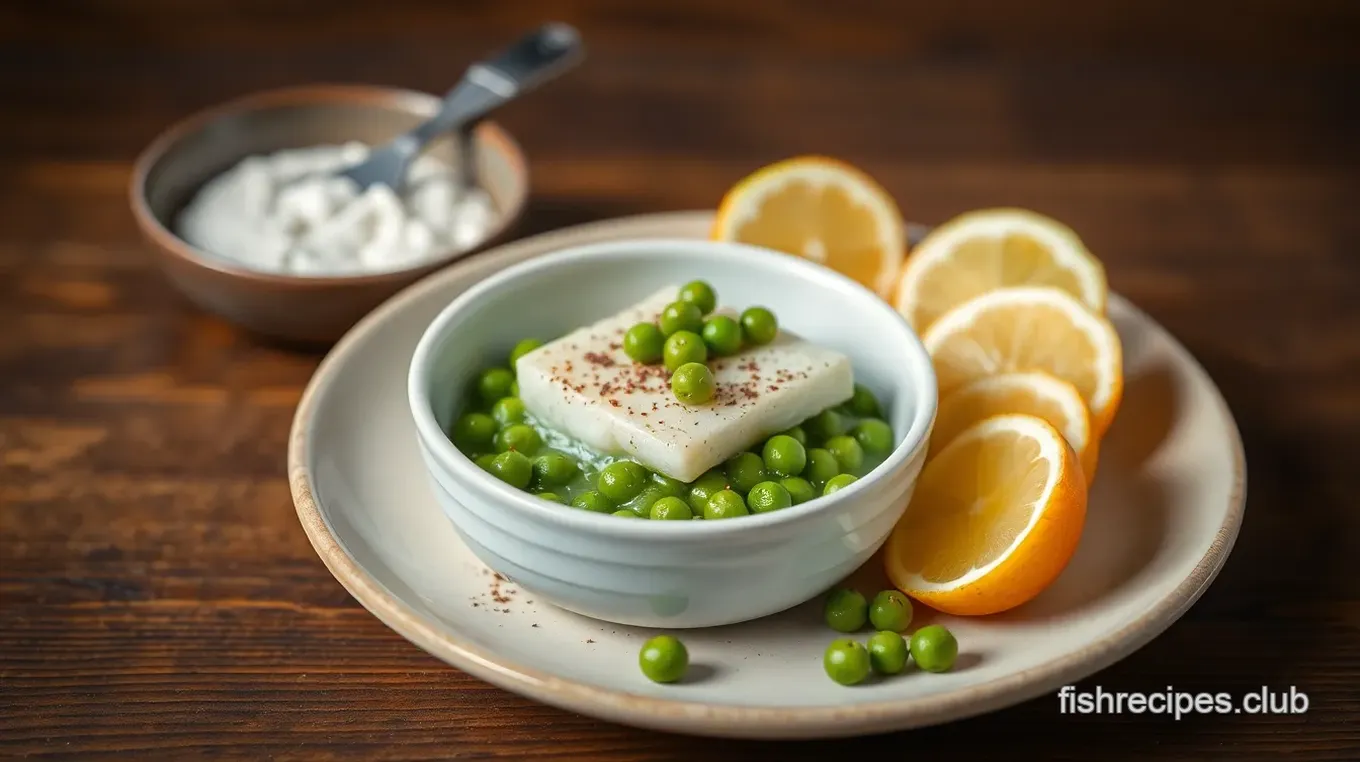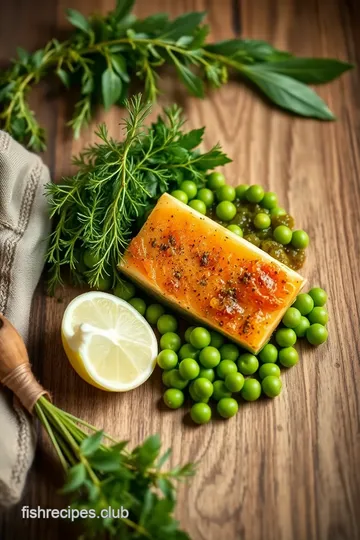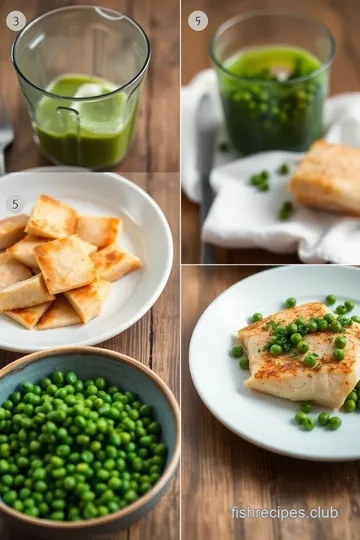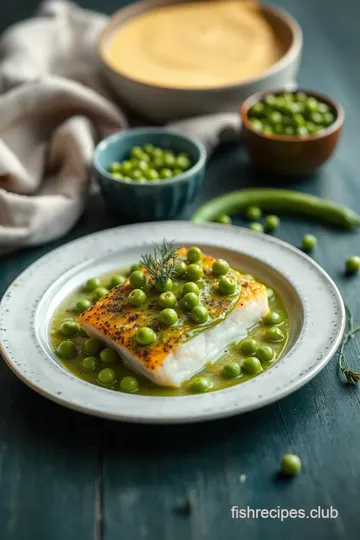Nutrient-Packed Spirulina & Pea Fish Blend
Looking for a nutritious meal for your fish? Try blending fish food with spirulina and peas! It's quick, healthy, and my aquarium loves it!

- look into Into the World of Homemade Fish Food
- Your Go-To Guide for Essential Ingredients in Fish Food
- look into Into Nutrient-Packed Cooking for Fish
- Pro Tips & Secrets
- Perfect Presentation
- Storage & Make-Ahead
- Creative Variations
- Complete Nutrition Guide
- Encouraging Conclusion
- Frequently Asked Questions
- Recipe Card
look into Into the World of Homemade Fish Food
Opening hook
let me take you back to that one summer afternoon when i decided to get all fancy and whip up my own fish food.
My aquarium had a troop of colorful fish doing their little wiggle dance, and i thought, "hey, why not treat them to something special?" i stumbled upon a recipe that said “ blend fish food with spirulina & peas ,” and oh my gosh, it was a game-changer! not only did my fish gobble it up, but they also seemed more vibrant and full of life.
It felt good knowing i was feeding my aquatic pals something nutritious. so if you're looking to jazz up your aquarium pets' diet, come along as we dive into the art of making your very own fish food!
Recipe Overview
Did you know the concept of homemade fish food dates way back? fish keepers have been crafting their own blends for ages, often drawing inspiration from traditional cuisine.
With the recent rise in interest for sustainable aquatic pet nutrition , now's the perfect time to try out your own fish food recipes.
This nutrient-packed spirulina & pea fish blend not only speaks to the trend of feeding our aquatic buddies healthier options, but it’s also super easy.
You’ll be at it for about 15 minutes, so even a busy bee can sneak this in. plus, it yields around four cups, which is a decent amount for any fish fan without breaking the bank.
Honestly, this recipe won’t cost you an arm and a leg. just a few simple ingredients that pack a nutritional punch!
Key Benefits
Let’s chat about the goodies in this fish food. spirulina is like a superhero for fish—loaded with omega-3 fatty acids , it boosts fish health and growth .
And who doesn’t want their fish to look vibrant and lively? the addition of peas offers a good dose of fiber, too.
These elements work together to create a balanced fish diet that meets their dietary requirements , making sure they glimmer in their tank like shiny little jewels.
If you’re hosting an aquarium party or just want to pamper your finned friends, this blend is spot on for special occasions.
You can effortlessly elevate their dining experience while knowing you're feeding them better than many of those high-quality fish food brands out there.
Plus, making your own fish food is also a fun way to dabble in easy fish food preparation !
Sharing this recipe is easy-peasy (pun totally intended). It’s surprisingly enjoyable to see your little companions thrive on something homemade—talk about a bonding experience!
Transition to Ingredients
Feeling excited yet? i know i am! let’s get into what you need to whip up this delightful blend. you’ll be blending simple ingredients that are easy to grab from your pantry or the freezer.
Grab your high-quality fish flakes , some frozen peas , and the magical spirulina powder . Trust me; it’s not just good for your fish but for you too! So, if you’re ready to treat your aquarium buddies to a delightful, homemade fish snack, let’s jump right into the ingredient list!

Your Go-To Guide for Essential Ingredients in Fish Food
Oh man, if you’re diving into the aquatic world of fishkeeping, you’re in for a treat! i mean, fish are like, the quietest pets—you can enjoy their beauty without all the barking or meowing.
But let’s talk about what really matters: feeding them well! the right ingredients can boost your fish health and make them pop with color.
So let’s jump into this essential ingredients guide that’ll get your fish on the path to a high-quality diet.
Premium Core Components
Imagine this—you’re at the store, and you grab some ingredients for your diy fish food. but do you really know what to look for? quality indicators can make or break your fish food recipes.
First up, measurements . for the right balance, you’ll want 1 cup (100g) of fish flakes , paired with ¼ cup (30g) of spirulina powder and 1 cup (100g) of frozen peas .
Trust me, each ingredient has a purpose that goes beyond just filling up a tank!
Storage? oh, it's crucial! keep your fish food in an airtight container to prevent spoilage. and don’t forget the shelf life of your ingredients—frozen peas can last up to six months, while quality fish flakes can hang around for a year if stored right.
Always check for freshness! freshness tips include smelling for anything funky and checking for clumping in your flake food. because, ew, stale fish food? no, thanks!
Signature Seasoning Blend
You think you can just toss in any herbs and spices? nah! when it comes to adding flavor enhancers in homemade fish food, you want to pay attention.
A good blend of essential spice combinations includes better-known ingredients like garlic powder—it's great for vitality. a sprinkle of herbs like dried dill can also pair surprisingly well with your fish food base.
You can diversify by exploring regional variations ; some folks love using seaweed in their blends, while others might lean toward vegetarian fish food options with ingredients like kale and carrots.
You really can customize it!
Smart Substitutions
What happens when you’re missing an ingredient? no panic necessary. this is where common alternatives come into play. if you find yourself out of spirulina, try chlorella powder instead.
Or if fresh peas aren’t in your freezer, frozen spinach could do the trick just fine. plus, using veggies can really enhance fish color and vitality —so don’t be afraid to experiment.
Need an emergency replacement? you can usually swap in fish oil with flaxseed oil for a plant-based source of omega-3.
Fish dietary requirements can be strict, but some creativity goes a long way! use seasonal options too; if it’s summer, fresh veggies from the market can really jazz things up.
Kitchen Equipment Essentials
Let’s talk about what you need to have in your kitchen. one of my biggest tips? keep it simple. a mixing bowl and a food processor are your best friends.
If you don’t have a fancy food processor, just make do with a sturdy blender or even a good old-fashioned mixing spoon .
Honestly, you don't need to spend tons on equipment—lifestyle changes don’t have to be expensive, right?
For storage solutions, have an airtight container ready! once your blend is made, you can stash it in the fridge for short-term use or freeze it for longer storage.
Oh, and let’s not forget: clean up is half the battle, so make sure to have a sponge handy!
Ready to blend some fish food? now that you’ve got a solid foundation on the essential ingredients , it’s time to actually do it! with the right mix of spirulina , peas , and other nutrient-dense ingredients, you can create a homemade fish food that’ll fuel your aquatic pets and keep them happy.
Imagine your fish thriving while you save money and feel like a rockstar fish chef!
Jump right into my next section for step-by-step instructions on how to pull all this together. I can’t wait for your fishies to feast on this delicious creation!

look into Into Nutrient-Packed Cooking for Fish
Cooking for our aquatic buddies can be as exciting as whipping up dinner for ourselves! today, i want to share my go-to recipe, nutrient-packed spirulina & pea fish blend .
This isn’t just any old fish food recipe; it’s a game-changer for your fish’s health and colors. let’s jump right in!
Essential Preparation Steps
Before we even think about blending fish food ingredients, let's talk mise en place . it’s french for "everything in its place," and trust me, it makes the process so much smoother.
Gather all your ingredients first. we're talking 1 cup of fish flakes (the good stuff, folks—high quality is key!), 1 cup of thawed peas , and a shop of spirulina .
Now, let’s chat time management. the beauty of our easy fish food preparation is that it only takes about 15 minutes .
Set a timer to keep things snappy. while your peas are thawing, you can pre-measure your other ingredients. i love this part because it feels so orderly—kind of like organizing my spice rack!
Don’t forget organization! when dealing with pets, safety is key . rinse everything well and ensure your workspace is clean. it’s like cooking for your family.
You wouldn’t want to serve up contamination, right?
Step-by-Step Process
Alright, let’s get down to the nitty-gritty with these clear, numbered instructions .
-
Prepare Ingredients : Grab your frozen peas , let ‘em thaw, and mash ‘em up real good.
-
Blend base ingredients : toss 1 cup (100g) of fish flakes , mashed peas, and ¼ cup (30g) spirulina powder in your food processor.
Pulse until it’s well blended. visual cues helped me here—look for a uniform color and texture.
-
Add Nutritional Boost : Next, add ½ cup (60g) blended fish pellets and ¼ cup (60ml) fish oil . Blend again until it’s silky smooth.
-
Store the blend : put your creations into an airtight container. you can chill it in the fridge, but if you want it to last, freeze them in portions.
Nothing worse than homemade fish food going stale!
When you’re feeding aquarium fish, timing and temperature can really make a difference. Make sure to serve it as they might prefer it at room temp!
Expert Techniques
Okay, here’s where it gets fun! Quality checkpoints are essential when blending. Always check that your fish flakes are fresh—nothing worse than stale food, for real.
One of my personal favorites? adding greens for variety! chopped spinach or kale can be a wonderful boost to this peas-and-spirulina party.
If you run low on spirulina powder, chlorella makes a great substitute. it’s like having a backup band ready to rock.
Troubleshooting Tips
Hey, mishaps happen! if the blend seems too sticky, don’t sweat it. add a touch more oil to loosen things up.
Also, consider the storage tips —if you find your fish blend isn’t lasting long enough, portion it out before freezing.
It’s just so much easier that way.
Success Strategies
Let me whisper some secrets to you. Common mistakes ? Overthinking! Don’t stress about making it perfect.
For quality assurance , keep the base ingredients fresh and rotate your offerings. fish love variety just like we do! if you want to boost that fish health and growth, remember to change up their diet regularly.
Lastly, for the perfect results guide, use the nutrients the fish need. My fish thrive on the healthy fats from omega-3 fish oil, making them vibrant and lively.
Nutrient-dense fish blends like this aren’t just a fun side project—they can significantly improve your fish's vitality. just think about it: adding peas to their diet can boost fiber and make them more active swimmers.
Who doesn’t want that?
Now, you’re ready to blend fish food with spirulina & peas like a pro! as you venture out to create these homemade fish gems, remember—they're not just food; they're an investment in your aquatic pet's nourishment.
Additional Information
Stay tuned as we dive deeper into ways to enhance your cooking and feeding practices! Each recipe opens a new door to better aquatic nutrition. Let’s keep those fins swimming strong, together!

Pro Tips & Secrets
Oh my gosh, if you want to blend fish food with spirulina & peas , you gotta have some insider tips! first off, choose a high-quality fish flakes brand.
Bad fish food can totally mess with your fish's health. seriously! use a base that's made for your specific fish type.
That dietary requirement is crucial.
For time-saving techniques , prep the peas beforehand. you know how they can get stuck in the freezer and you forget about them? thaw them a day before, and you’re golden.
Just mash ‘em right before blending. and honestly, don’t skimp on the oils! fish oil or omega-3 oil really ramps up the flavor and provides healthy fats.
Your fish will thank you!
Now, for enhancing flavors, try tossing in some pureed carrots or even spinach! your fish will love munching on those goodies.
And don’t forget about presentation: serve it in a cool feeding ring. it’ll make your aquarium look like a five-star restaurant!
Perfect Presentation
Plating isn’t just for fancy restaurant meals. think of your aquatic pets’ dining scene! start using vibrant colors in your fish blends.
The green from peas and the deep hue of spirulina make such a beautiful backdrop. it’s like nature’s display of color right in your tank!
When it comes to garnishing, sprinkle some finely chopped parsley on top before serving — not only does it look great, but it adds a little extra zest.
Use a clear feeding bowl for your fish to make it pop against the substrate. honestly, fish will love the visual feast just as much as the food!
Storage & Make-Ahead
Now, let’s talk storage. here’s the deal: make a big batch of this nutrient-dense fish blend and store ‘em in airtight containers.
Seriously, don't skip this step. the blend will last in the fridge for a week, but if you want to keep it fresher for longer, pop it in the freezer!
To reheat, just let it sit at room temperature for about 30 minutes before serving. no one wants icy fish food.
And remember, freshness counts. the sooner you feed it to your fish, the better the nutrients will be absorbed.
Creative Variations
Feeling adventurous? try these seasonal twists . you can mix in some grated zucchini for summertime or some breadcrumbs for heartiness in winter.
Not to mention, spiralizing veggies can give a fun twist to your fish diet. just keep those dietary modifications in mind based on your fish needs.
If you’ve got vegan fish , toss in some spirulina alternatives like chlorella. they are great too! but keep in mind, if you’re looking to keep your fish happy and growing, balance is key, so don’t overload them with just plant-based ingredients.
Complete Nutrition Guide
This easy fish food preparation packs a serious punch in nutrition. Providing a breakdown like this can be super helpful:
- Calories: 200 per cup
- Protein: 15g — essential for growth and vitality
- Fat: 10g — great for that shiny look!
- Fiber: 5g — helps with digestion
These numbers can vary, but one thing is for sure — your aquatic pets are getting quality nutrients. regularly changing the blend and keeping it diverse will help maintain their overall well-being.
Fish health and growth totally depend on what you feed them!
Encouraging Conclusion
So, next time you’re in the kitchen, take a little extra time and whip up this homemade fish food . your fish deserve the best nutrition, and i hope these tips give you all the confidence you need.
Remember, creating this blend is not just about feeding your fish; it’s about crafting little bits of goodness that promote vibrant health.
Look into in, get creative, and enjoy the journey of nurturing your beloved aquatic pals! happy blending!
Frequently Asked Questions
What are the benefits of blending fish food with spirulina and peas?
Blending fish food with spirulina and peas creates a nutrient-packed diet for your fish, promoting healthy growth and vibrant colors. Spirulina is rich in proteins and essential fatty acids, while peas provide fiber and vitamins. Together, they enhance the overall well-being of your aquatic pets.
How do I properly store the blend after I make it?
After blending your fish food with spirulina and peas, transfer the mixture into an airtight container. For optimal freshness, store it in the refrigerator if you plan to use it within a week or freeze it in portion-sized amounts for longer shelf life. This helps preserve nutrients and prevents spoilage.
Can I use fresh peas instead of frozen for the Blend Fish Food with Spirulina & Peas?
Yes, you can use fresh peas instead of frozen. However, make sure to cook them briefly and then mash them before adding to the blend, as this will help soften them for easier incorporation. Just ensure they are cool before mixing to avoid cooking the other ingredients.
What variations can I try for the Blend Fish Food with Spirulina & Peas?
You can experiment by adding other vegetables, such as finely grated carrots or chopped spinach, to enhance the nutritional profile. Different algae powders can be used instead of spirulina for a change in flavor and nutrition. Additionally, consider substituting fish oil with flaxseed oil for a plant-based omega-3 boost.
Is this blend suitable for all types of fish?
While the Blend Fish Food with Spirulina & Peas is beneficial for many fish, it's essential to consider the specific dietary needs of your fish species. Most freshwater fish will thrive on this blend, but it's best to consult with a fish specialist to ensure it meets the requirements for your particular type of fish.
How often should I feed my fish the spirulina and pea blend?
Introduce the blend gradually into your fish's diet, feeding small amounts 2-3 times a week. Regularly rotating their diet helps ensure they receive a balanced nutrition while keeping them excited about meal times. Overfeeding can lead to water quality issues, so be mindful of portion sizes.
Nutrient-Packed Spirulina & Pea Fish Blend Card

⚖️ Ingredients:
- 1 cup (100g) fish flakes
- 1 cup (100g) frozen peas, thawed and mashed
- ¼ cup (30g) spirulina powder
- ½ cup (60g) blended fish pellets
- ¼ cup (60ml) fish oil or omega-3 oil
🥄 Instructions:
- Step 1: Gather all ingredients and equipment. Thaw frozen peas and mash them in a bowl.
- Step 2: In a food processor, combine fish flakes, mashed peas, and spirulina powder. Pulse until the mixture is well combined.
- Step 3: Incorporate blended fish pellets and fish oil into the mixture. Blend again until a uniform consistency is achieved.
- Step 4: Transfer the blend to an airtight container. Refrigerate or freeze in portions, depending on usage.
Previous Recipe: How to Make the Ultimate Cooked Spanish Fish Stew with Potatoes
Next Recipe: How to Fry Cornmeal Fish with Flavorful Seasoning: A Delicious Family Favorite
